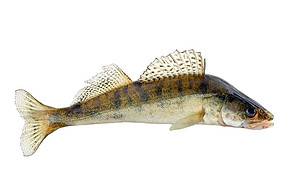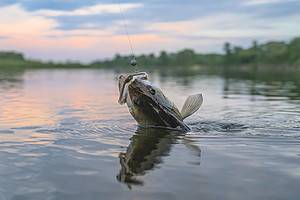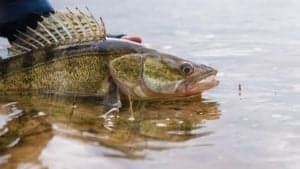The walleye, alternatively known as the yellow pike or yellow pickerel, is a popular game fish in North America thanks to its abundance and fairly manageable size. It’s also an important food source in the Upper Midwest region to both humans and animals alike. Its cultural significance throughout the colder regions of North America has even led to it becoming the official state fish of several northern US states as well as the official provincial fish of Manitoba, Canada. But how big do these hardy, fascinating, and tasty fish get? Let’s take an in-depth look at the walleye’s size, its growth rate, and more.
Get to Know the Walleye: A Brief Overview
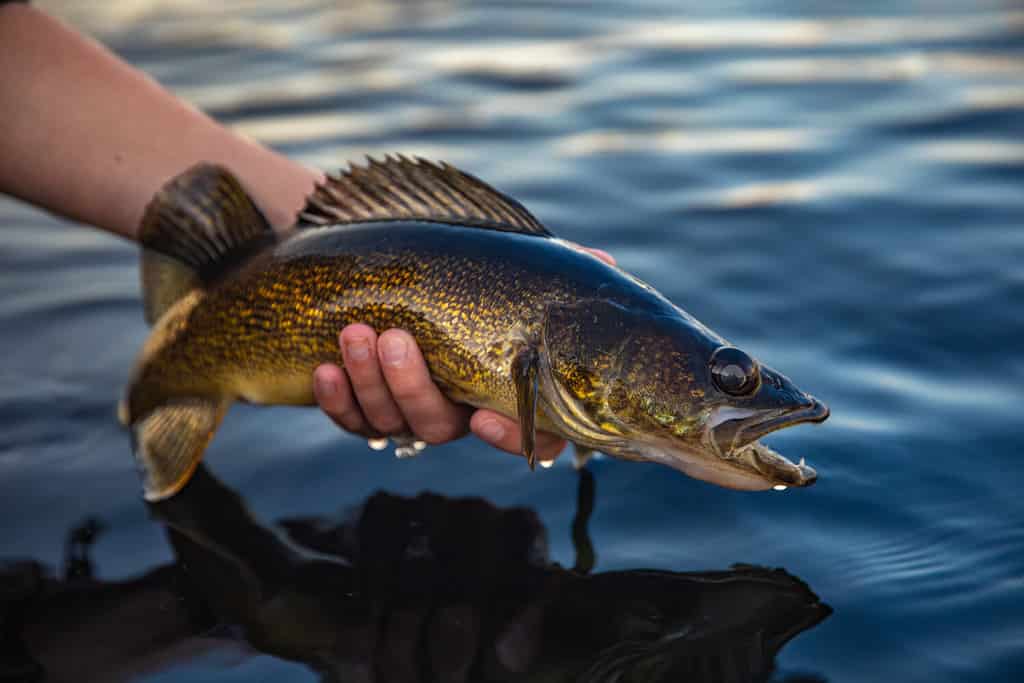
The walleye gets its common name from its large, pearlescent eyes.
©Harlan Schwartz/Shutterstock.com
Like we briefly covered earlier, the walleye goes by a few common names, including the yellow pike, yellow pikeperch, and the yellow pickerel. Its taxonomic name is Sander vitreus. A ray-finned, perciform (Latin for “perch-like” in appearance) fish, it falls under the Sander genus of fish that includes five main species of perches, ruffes, and darters.
As a group, fish in the Sander genus like the walleye have long, slender bodies. Collectively, they range from around 10 to 50 inches long, with the walleye being towards the smaller end of the spectrum. Most species are native to the northern hemisphere, specifically North America or Eurasia. Generally, they live in freshwater. However, they can also sometimes survive in more brackish conditions.
Specifically, walleyes are mostly golden and olive greenish-brown in color. Their rich coloration is accented by five darker saddle-like markings along their backs. Their bellies are white or cream-toned.
Like most species in the Sander genus, walleyes have uniquely sharp, canine-like teeth and are equipped with a reflective layer of tissue in their eyes that helps them see exceptionally well in low-light conditions. They actually get their common name from this reflective layer of tissue, which makes their eyes look eerily pearlescent and opaque.
Thanks in part to these helpful adaptations, fish like the walleye mainly eat other, smaller fish. They also primarily feed at night in rough waters anglers often refer to as “walleye chop.” Notably, anglers often seek out more turbid waters and fish at night for walleyes, as these are the conditions in which they are most active.
How Big Are Newly-Hatched and Juvenile Walleyes?
Upon hatching, a walleye fry is typically only around a half-inch long or less. However, during their first year of life, they grow fairly quickly. As a sexually dimorphic species, males are generally larger than females during their early life stages, but the females eventually outgrow them. Notably, growth rates can vary slightly depending on the region–southern populations of walleyes tend to grow a bit larger and faster than those living further north.
After their first six to eight months of life, walleye fry quickly grow in size as they enter their juvenile life stage. By the time they are around one year old, most specimens reach 4 to 5 inches long and weigh around one-fifth of a pound. At two years of age, walleyes are roughly 6 to 8 inches long and weigh half a pound or so.
Walleyes leave their juvenile stage at different points depending on their sex. While male walleyes are considered fully mature at around two to three years old, females mature a bit more slowly, reaching maturity at around five years of age.
How Big Do Fully-Grown Walleyes Get?
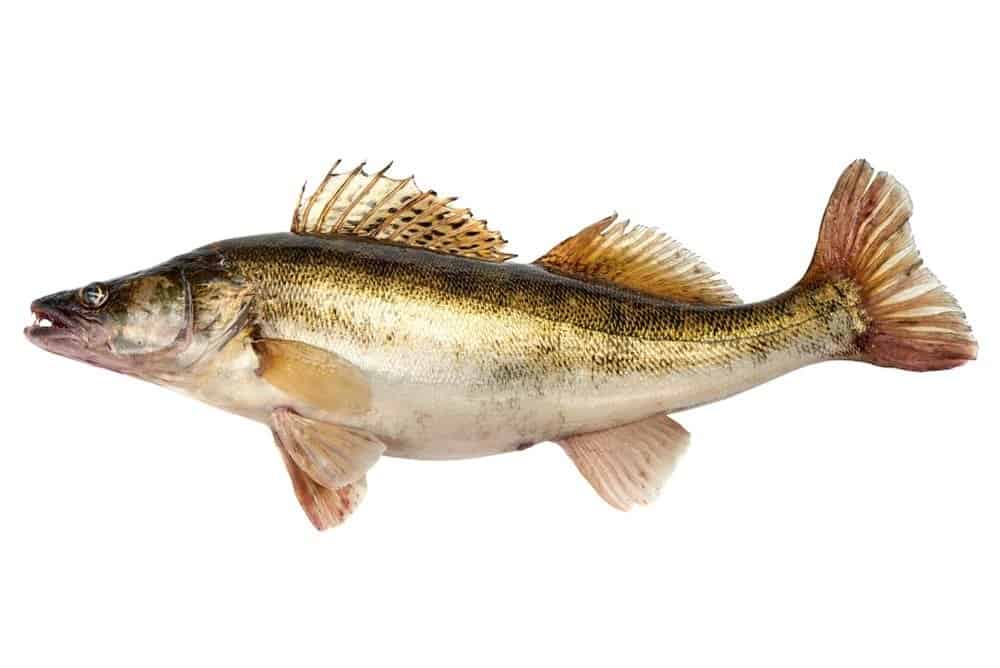
When fully mature, walleyes can weigh more than 20 pounds. Most, however, average much less than this at one to five pounds.
©GSDesign/Shutterstock.com
Upon reaching sexual maturity, most adult walleyes are around 10 to 20 inches long. However, especially lengthy specimens can reach more than 30 inches from nose to tail fin tip!
Similarly, an adult walleye’s maximum weight can vary from as little as a single pound to 20 pounds or more. The average walleye caught by most anglers only weighs around two to three pounds. The largest walleye ever recorded, though, weighed a whopping 25 pounds, four ounces. It was caught at Old Hickory Reservoir in Tennessee in 1960 by angler Mabry Harper around 25 miles outside of Nashville.
Although walleyes are fully mature at two to five years of age, they can continue growing well into their adult years. They can live for decades, but most don’t live longer than a few years or so in the wild. The lucky individuals that make it to 10 to 15 years old can weigh anywhere from 3 to 10 pounds on average and measure 20 to 30 inches long.
Notably, at this life stage, female walleyes are generally larger in size than males. This is because their bodies must be larger to sustain large clutches of eggs. A single female can lay around half a million eggs in her lifetime!
Walleye Average Growth Rates at a Glance: Size Chart
| Age/Life Stage | Average Length | Average Weight |
| <6 months (Hatchling/Fry) | 0.2″ to 0.5″ | N/A |
| 6 months – 1 Year (Juvenile) | 4″ to 5″ | 0.2 to 0.4 pounds |
| 2-3 Years (Sub-Adult) | 6″ to 10″ | 0.5 to 1 pound |
| 3-5 Years (Fully Mature Adult) | 8″ to 12″ | 1 to 5 pounds |
| 5+ Years | 10″ to 20″+ | 3 to 10+ pounds |
What is the Largest Walleye Ever Recorded?
Like we touched on earlier, the largest walleye ever caught was 25 pounds, 4 ounces and, according to most IGFA and Freshwater Fishing Hall of Fame experts today, around 41 inches long. However, there is quite a bit of controversy and an interesting backstory behind this catch landed way back in 1960 by Tennessee angler Mabry Harper.
Historically, Harper’s record has long been heavily disputed. When he originally submitted the record to Field and Stream, photos of the catch were the subject of major controversy. Many anglers and fishing experts claimed the fish couldn’t have been 41 inches long or 25 pounds based on the photos provided by Harper.
Eventually, the record-breaking catch became so controversial and subject to dispute that the record was revoked in 1996, only to later be reinstated after affidavits surfaced proving the fish’s measurements. According to Tennessee game warden at the time, James Spurling, Mabry’s massive walleye and its measurements are, in fact, legitimate.
But many anglers still aren’t convinced–as it stands, only time will tell if another angler will beat this record or manage to disprove it in the future. Interestingly, some still regard the Arkansas state record caught by angler Al Nelson in 1982 to be the “actual” world record. For reference, Nelson’s respective catch weighed 22 pounds, 11 ounces.
For a brief period in time when Mabry’s record was at the height of its controversy, Nelson’s catch was largely regarded as the world record. The talented angler caught the 22-pounder at Greer’s Ferry Lake in northern Arkansas. No matter which record you consider to be the more legitimate of the two, both are undoubtedly historically significant.
Best Places and Time of Year to Catch Walleye
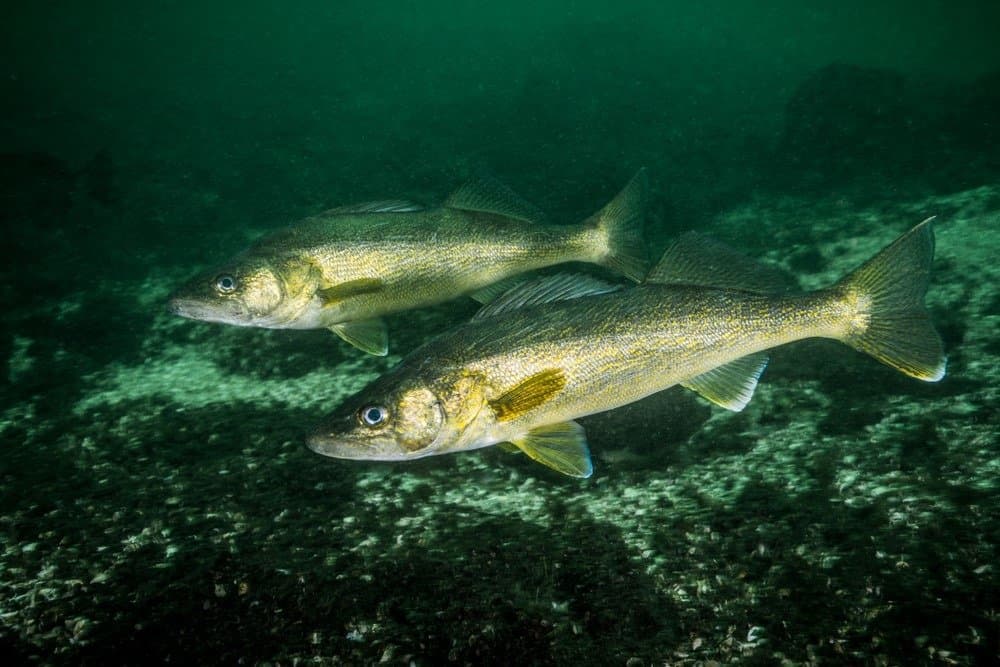
Walleye generally prefer rough, deep waters.
©RLS Photo/Shutterstock.com
While walleyes are now widespread throughout much of the northern half of the United States and Canada, they are most abundant in and native to the Upper Midwest and northeastern reaches of North America. They are technically freshwater fish, though they can also tolerate more brackish conditions.
As walleyes prefer to hunt their prey at night, most anglers opt to fish for them during the hours of dawn and dusk. Thanks to their aforementioned tapetum lucidum covering each eye, walleyes have excellent night vision. Additionally, their razor-sharp teeth are perfect for tearing into their prey, which tends to be other, smaller fish. They are also fairly strong swimmers, and they usually hunt in more turbid, rough waters.
Most anglers opt to search for walleyes near rocky ledges and outcrops at depths of at least 10 feet. However, walleyes will also venture into slightly shallower waters, primarily during their optimal feeding times around dusk and dawn.
The best time of year to catch walleyes varies somewhat depending on where you live. In the Upper Midwest where the species is most abundant, the spring and summer months tend to bring anglers the most success. In warmer, more southern regions, the fall and winter months are more ideal.
The photo featured at the top of this post is © Harlan Schwartz/Shutterstock.com
Thank you for reading! Have some feedback for us? Contact the AZ Animals editorial team.




